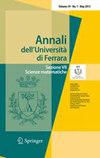Auxiliary particle filtering with lookahead support for univariate state space models
Abstract
An essential type of Bayesian recursive filters known as the sequential Monte Carlo (alias, the particle filter) is used to estimate hidden Markov target states from noisy sensor data. Utilising sensor data and a collection of weighted particles, the filter makes an approximation of the posterior probability density of the target state. These particles are made to recursively propagate in time and are then updated using the incoming sensor information. The auxiliary particle filter improves over the traditional particle filter by guiding particles into regions of importance of the probability density using a lookahead scheme. This facilitates in the use of fewer particles and improved accuracy. However, when the sensor observations are extremely informative and the state transition noise is strong, the filter suffers badly. This is because the high state transition noise causes the particles that are determined to be important by the lookahead step could guide themselves to unimportant regions of the posterior in the final sampling process. Recent improvements of the auxiliary particle filter explored better weighting strategies but the said problem has not been explored closely. This paper seeks to solve the problem by adopting an auxiliary lookahead technique with two predictive support points to estimate the particles that will be located in regions of high importance after final sampling. The proposed method is successfully tested using a nonlinear model using simulations.

 求助内容:
求助内容: 应助结果提醒方式:
应助结果提醒方式:


